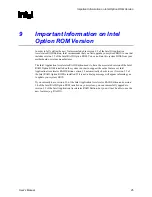
RAID
Background
R
User's Manual
11
2 RAID
Background
RAID (Redundant Array of Inexpensive Disks) was originally conceived at the University of
California at Berkeley in 1987 by David A. Patterson, Garth Gibson, and Randy H. Katz. The
focus of their research was to improve storage subsystem performance and reliability. As a result
of their findings, they proposed five levels of RAID (RAID 0 – RAID 5) to provide a balance of
performance and data protection. Each RAID level is designed for speed, data protection, or a
combination of both. Patterson, Gibson, and Katz published their findings in a document titled “A
Case for Redundant Arrays of Inexpensive Disks (RAID).” This
University of California, Berkeley:
http://sunsite.berkeley.edu/TechRepPages/CSD-87-391
RAID was designed to improve the way computers manage and access mass storage of data by
providing an independent and redundant system of disks. Instead of writing to one Single Large
Expensive Disk (SLED), RAID writes to multiple independent disks.
Summary of Contents for Application Accelerator RAID Edition
Page 1: ...Intel Application Accelerator RAID Edition User s Manual Revision 1 1 July 2003 ...
Page 8: ...R 8 User s Manual This page is intentionally left blank ...
Page 10: ...Scope of This Document R 10 User s Manual This page is intentionally left blank ...
Page 12: ...RAID Background R 12 User s Manual This page is intentionally left blank ...
Page 14: ...RAID 0 Striping R 14 User s Manual This page is intentionally left blank ...
Page 16: ...RAID 1 Mirroring R 16 User s Manual This page is intentionally left blank ...
Page 18: ...RAID Migration Feature R 18 User s Manual This page is intentionally left blank ...
Page 24: ...BIOS Importance Settings R 24 User s Manual This page is intentionally left blank ...
Page 40: ...Intel RAID Option ROM R 40 User s Manual This page is intentionally left blank ...
Page 52: ...Issues During Installation R 52 User s Manual This page is intentionally left blank ...


























